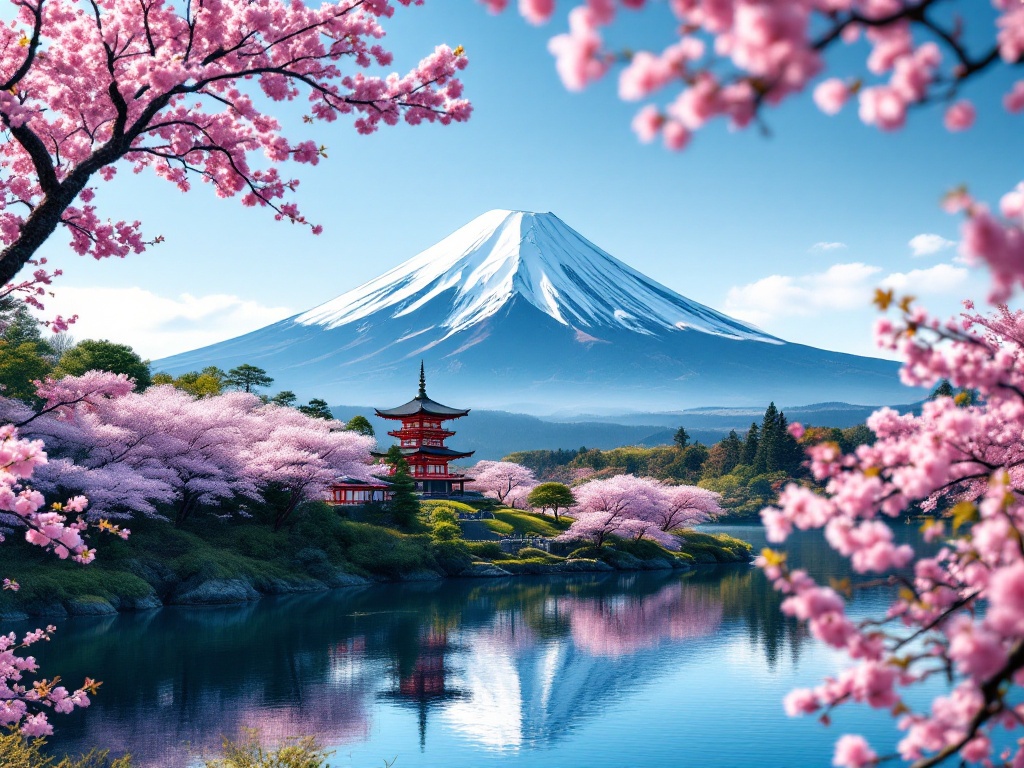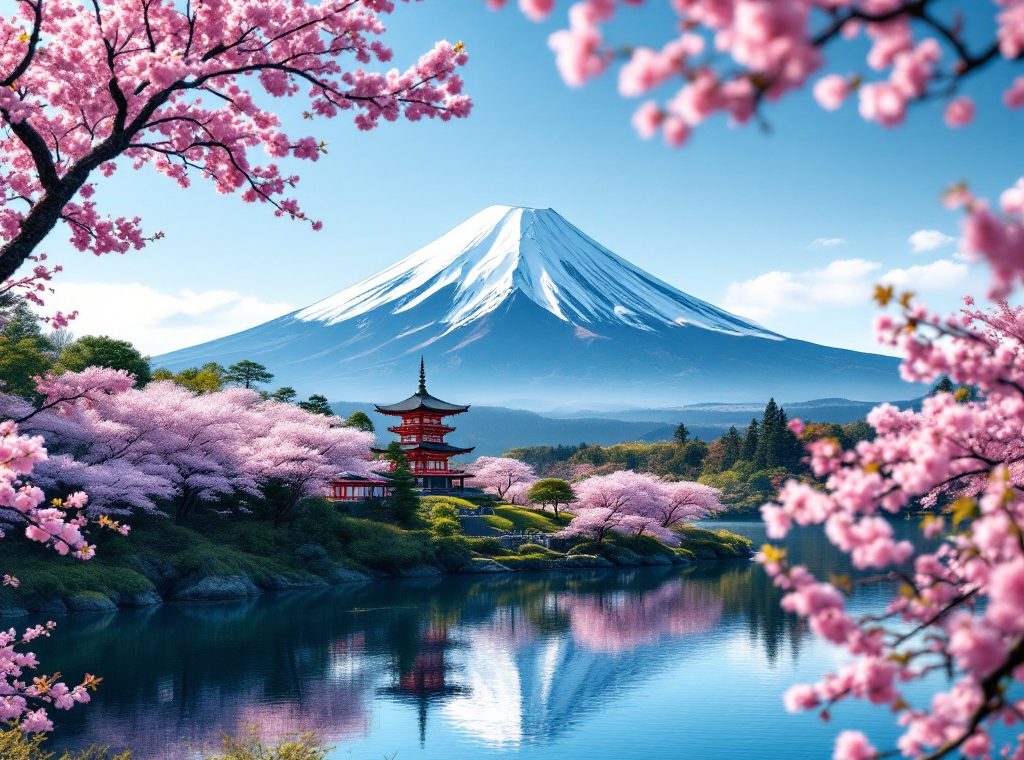How to Organize Your Mount Fuji Day Trip from Tokyo
Dreaming of witnessing Mount Fuji’s majestic peak? This guide helps you plan the perfect day trip from Tokyo. Learn how to maximize your chances of clear views of Japan’s highest point (3,776 meters!), discover the best travel options (train, bus, or car?), and explore top attractions like the Fuji Five Lakes and Chureito Pagoda. Start planning your unforgettable Mount Fuji adventure today!
Important information

- Mount Fuji, Japan’s highest peak (3,776 meters), offers stunning views, best seen October to January.
- Travel options from Tokyo include highway bus (budget-friendly), Fuji Excursion Train (scenic), or rental car (flexible).
- Popular attractions include the Fuji Five Lakes, Oshino Hakkai village, Chureito Pagoda, and Oishi Park.
- Pack for all weather conditions with layers, comfortable shoes, and sun protection. Carry cash, especially for smaller vendors.
- Be prepared for unpredictable weather and potential altitude sickness. Stay hydrated and descend if you feel unwell.
Planning Your Mount Fuji Day Trip from Tokyo
A well-planned day trip from Tokyo to Mount Fuji offers a rewarding experience. Japan’s highest peak, towering at 3,776 meters (12,388 feet), provides breathtaking views. For the clearest vistas, visit from October through January. However, remember that clear visibility averages just 20-30%, so plan your trip with this in mind.
Why a Day Trip to Mt. Fuji is Worth It
Experiencing Mount Fuji on a clear day is breathtaking. As Japan’s highest peak, this iconic landmark offers incredible views. A day trip perfectly captures its majesty and the surrounding natural beauty.
Best Time for Your Trip: Seasonal Considerations
Mount Fuji is best viewed during the crisp, dry months of winter, offering unparalleled clarity. While summer’s warmth is tempting, clouds frequently obscure the peak. For optimal viewing, consider dawn or dusk, as midday visibility can be unpredictable.
Transportation Options for Your Day Trip
Planning a Mount Fuji day trip from Tokyo? The journey takes about two to three hours, and you have several transport options.
Highway Bus
For a convenient and budget-friendly trip, take a highway bus directly to Mount Fuji. Buses depart from major Tokyo hubs like Shinjuku and Shibuya.
Fuji Excursion Train
The scenic Fuji Excursion train departs from Shinjuku Station, reaching Mount Fuji in just under two hours. Enjoy breathtaking views along the way.
Bus vs. Train
Buses offer a direct, economical ride. The Fuji Excursion train provides stunning views but at a slightly higher cost. Choose what suits your priorities.
Car Rental
Rent a car for maximum freedom and flexible sightseeing. Be mindful of potential traffic, parking fees, and navigating unfamiliar roads.
Choosing Between Train and Bus
Planning a Mount Fuji trip from Tokyo? The most economical travel option is by highway bus. For a more comfortable journey with stunning scenery, consider the Fuji Excursion train.
Travel Times and Routes
Planning a Mount Fuji trip from Tokyo? A bus gets you there in two to three hours, while the train takes just under two hours. Either way, you’ll have easy access to the mountain’s attractions.
Renting a Car for a DIY Experience
A rental car offers the freedom to explore Mount Fuji at your own pace.
Japan’s efficient and economical public transportation system, with its convenient buses and trains, is a viable alternative.
Weigh your budget, desired level of control, and comfort needs to determine the best travel option.
Group Tours vs. Independent Travel
Group Tours
Group tours offer a hassle-free travel experience, with pre-arranged transportation, itineraries, and guided commentary. This allows travelers to simply relax and enjoy the journey.
Independent Travel
Independent travel provides greater flexibility and personalized exploration. You control your schedule, deciding where to go and how long to stay, lingering at your favorite spots.
Benefits of Joining a Group Tour
Experience Mount Fuji effortlessly with a well-organized group tour. Structured itineraries efficiently cover key attractions. Knowledgeable guides provide valuable insights into the mountain’s history, geology, and cultural significance. With transportation often included, travel logistics are simplified, allowing you to relax and fully immerse yourself in the experience.
Key Benefits of a Mount Fuji Group Tour:
- Effortless experience, focusing on enjoyment rather than logistics.
- Structured itineraries ensure efficient coverage of major attractions.
- Expert guides offer insights into the mountain’s rich history, geology, and cultural significance.
- Simplified logistics with transportation often included, reducing travel stress.
- Immersive experience, allowing for full appreciation of Mount Fuji’s beauty and significance.
Focus on Relaxation and Enjoyment:
By joining a group tour, you can bypass the complexities of planning transportation, accommodations, and sightseeing. This allows you to fully relax and immerse yourself in the breathtaking scenery and cultural richness of Mount Fuji.
How to Enjoy a DIY Day Trip
Planning a trip to Mount Fuji? Here’s how to make it unforgettable.
Consider a Japan Rail Pass for efficient travel on the bullet train. However, don’t miss the scenic views offered by local buses.
Renting a car offers flexibility. Make sure you have an International Driving Permit.
Carry cash, as smaller vendors may prefer it.
Pre-book your accommodations, especially for overnight stays.
Pack snacks and water, particularly if you plan on hiking.
Check the weather forecast and dress accordingly.
Explore the Fuji Five Lakes area. This area offers diverse activities like hiking, boat tours, and ropeway rides.
Top Attractions to Visit on Your Day Trip
Explore the Fuji Five Lakes region, starting with Lake Kawaguchiko, famous for its breathtaking reflections of Mount Fuji. Visit the charming village of Oshino Hakkai, featuring eight sacred ponds and traditional houses. Capture stunning photos of Mount Fuji framed by the five-storied Chureito Pagoda. Enjoy the vibrant seasonal flowers at Oishi Park on Lake Kawaguchiko’s shores with Mount Fuji as a backdrop.
Exploring the Fuji Five Lakes
Nestled at the base of Mount Fuji are the Fuji Five Lakes: Kawaguchiko, Yamanakako, Saiko, Shojiko, and Motosuko. Each lake offers breathtaking views of the majestic peak and a variety of recreational activities, from boating and fishing to invigorating hikes.
Kawaguchiko, the most accessible of the five, is famous for its relaxing hot springs and proximity to the Kawaguchiko Music Forest Museum. Yamanakako, the largest lake, attracts visitors with opportunities for water sports and camping.
A canal connects Saiko and Shojiko. Saiko is known for its unique caves and fascinating lava formations. The serene beauty of Shojiko makes it a perfect spot for photography enthusiasts.
Motosuko, the deepest lake, is featured on the 1,000 yen bill. Kayaking and camping are popular activities here, surrounded by stunning scenery.
Must-See Spots: Lake Kawaguchiko and Oshino Hakkai
Lake Kawaguchiko, one of the Fuji Five Lakes easily accessible from Tokyo, offers breathtaking views of Mount Fuji. The nearby village of Oshino Hakkai is known for its eight sacred ponds, celebrated for their crystal-clear water. Fed by underground springs originating from Mount Fuji’s snowmelt, these ponds make Oshino Hakkai a place of significant natural and cultural importance.
Photo Opportunities: Chureito Pagoda and Oishi Park
Chureito Pagoda offers breathtaking views of Mount Fuji, especially stunning when framed by springtime cherry blossoms or vibrant autumn foliage. For a different perspective, visit Oishi Park on the shores of Lake Kawaguchiko. Here, you can capture panoramic views of the mountain mirrored in the serene water. Both locations are easily accessible and provide diverse photo opportunities, allowing you to capture Fuji’s beauty from every angle.
Chureito Pagoda
Experience breathtaking views of Mount Fuji, especially captivating when framed by springtime cherry blossoms or the vibrant colors of autumn foliage.
Oishi Park
Capture panoramic views of Mount Fuji mirrored in the serene waters of Lake Kawaguchiko, offering a unique and tranquil perspective.
Both locations are easily accessible and offer diverse photo opportunities, allowing you to capture the beauty of Mount Fuji from every angle.
Additional Tips for a Successful Day Trip
Pack smart for your outdoor adventures with comfortable clothes and durable walking shoes. A light jacket is recommended, as temperatures can change rapidly. Don’t forget essential sun protection like a hat and sunscreen, and bring a reusable water bottle to stay hydrated. If you’re planning a hike, a small backpack with snacks and a camera will come in handy.
Essential Items
- Comfortable clothes and durable walking shoes.
- A light jacket.
- Sun protection (hat and sunscreen).
- Reusable water bottle.
- Small backpack (for hikes).
- Snacks and a camera (for hikes).
Mount Fuji Weather and Altitude
Mount Fuji’s weather is notoriously unpredictable, so check the forecast before heading out and dress in layers. Altitude sickness can be an issue at higher elevations. Symptoms include headaches and nausea. If you start feeling unwell, descend to a lower altitude, drink plenty of water, and avoid strenuous activity.
What to Pack: Essentials for Your Trip
For snacks, souvenirs, lunches, and tips, cash is king. Comfortable walking shoes are essential, and dress according to the weather. If you plan on hiking, a small backpack is useful for carrying trekking poles, a first-aid kit, and other essentials like a portable charger, camera, and water bottle.
Dealing with Weather and Altitude Sickness
Packing layers is essential for adapting to Mount Fuji’s unpredictable weather. Hydration is also crucial for preventing altitude sickness during the climb, so drink plenty of water. Here’s a helpful checklist for your climb:
- dress in layers to adjust to changing temperatures,
- hydrate regularly to combat altitude sickness,
- pack snacks for sustained energy.









